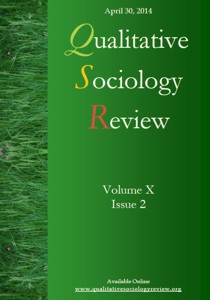Tension in the Field of Art: The Practical Tattoo Artist and Perceptions of the Fine Art Community
DOI:
https://doi.org/10.18778/1733-8077.10.2.06Keywords:
Tattoo Artists, Collaborative Circles, Taste, Boundary Making, Goal OrientationAbstract
This is an ethnographic study utilizing observation and in-depth interviews. The following research analyzes a collaborative circle of tattoo artists and its tension with the fine art community. The tension is a result of perceptions of the fine art community and the nature of tattoo shops as enterprises. This article contributes to the understanding of collaborative circles by incorporating taste distinctions and a formal group element, the enterprise. Taste distinctions and the enterprise allow artists to erect boundaries between themselves and others in the art community.
Downloads
References
Becker, Howard S. 1982. Art Worlds. Berkeley, CA: University of California Press.
Google Scholar
Bourdieu, Pierre. 1979. Distinction: A Social Critique of the Judgment of Taste. Boston, MA: Harvard University Press.
Google Scholar
Bourdieu, Pierre. 1982. Language and Symbolic Power. Cambridge: Polity Press.
Google Scholar
Bourdieu, Pierre. 1996. The Rules of Art: Genesis and Structure of the Literary Field. Stanford, CA: Stanford University Press.
Google Scholar
DOI: https://doi.org/10.1515/9781503615861
Collins, Randall. 2004. Interaction Ritual Chains. Princeton, NJ: Princeton University Press.
Google Scholar
DeMello, Margo. 2000. Bodies of Inscription: A Cultural History of the Modern Tattoo Community. Durham, NC: Duke University Press.
Google Scholar
DOI: https://doi.org/10.2307/j.ctv1168d0t
Farrell, Michael P. 2001. Collaborative Circles: Friendship Dynamics & Creative Work. Chicago: University of Chicago Press.
Google Scholar
Fischer, Claude S. 1982. To Dwell Among Friends: Personal Networks in Town and City. Chicago: University of Chicago Press.
Google Scholar
Grossi, Anna Marie. 2007. “Piercing, Tattoos, and Branding: Latent and Profound Reasons for Body Manipulations.” Pp. 285- 291 in Machines That Become Us: The Social Context of Personal Communication, edited by James E. Katz. New Brunswick, NJ: Transaction Publishers.
Google Scholar
DOI: https://doi.org/10.4324/9780203786826-21
Hitlin, Steven and Glen H. Elder, Jr. 2007. “Time, Self, and the Curiously Abstract Concept of Agency.” Sociological Theory 25(2):170-191.
Google Scholar
DOI: https://doi.org/10.1111/j.1467-9558.2007.00303.x
Irwin, Katherine. 2003. “Saints and Sinners: Elite Tattoo Collectors and Tattooists As Positive And Negative Deviants.” Sociological Spectrum 23:27-57.
Google Scholar
DOI: https://doi.org/10.1080/02732170309206
Johnson, Jeff. 2008. Tattoo Machine. New York: Random House.
Google Scholar
Jones, Michael A., Thomas J. Lipscomb, and Jeff W. Totten. 2009. “Attitudes Toward and Stereotypes of Persons With Body Art: Implications for Marketing Management.” Academy of Marketing Studies Journal 13(2):77-96.
Google Scholar
Kosut, Mary. 2006. “Mad Artists and Tattooed Perverts: Deviant Discourse and the Social Construction of Cultural Categories.” Deviant Behavior 27:73-95.
Google Scholar
DOI: https://doi.org/10.1080/016396290950677
Lin, Nan. 1999. “Building a Network Theory of Social Capital.” Connections 22(1):28-51.
Google Scholar
Penn, Mark J. and E. Kinney Zalesne. 2007. Microtrends. The Small Forces Behind Tomorrow’s Big Changes. New York: Twelve.
Google Scholar
Timming, Andrew R. 2011. “What Do Tattoo Artists Know About HRM? Recruitment and Selection in the Boy Art Sector.” Employee Relations 33(5):570-584.
Google Scholar
DOI: https://doi.org/10.1108/01425451111153916
Downloads
Published
How to Cite
Issue
Section
License

This work is licensed under a Creative Commons Attribution-NonCommercial-NoDerivatives 4.0 International License.











